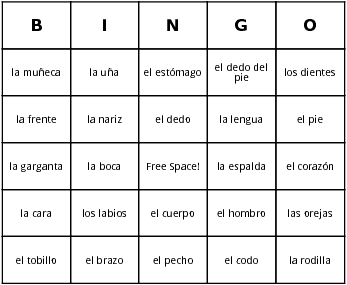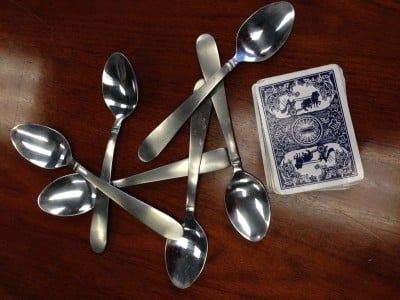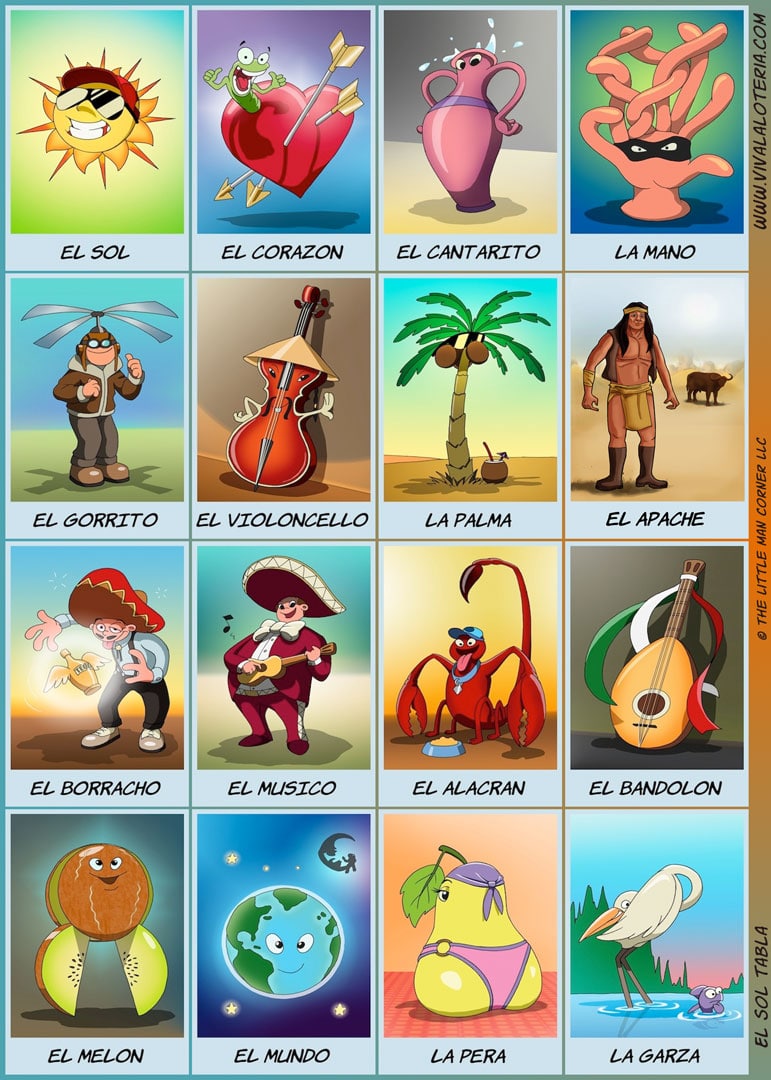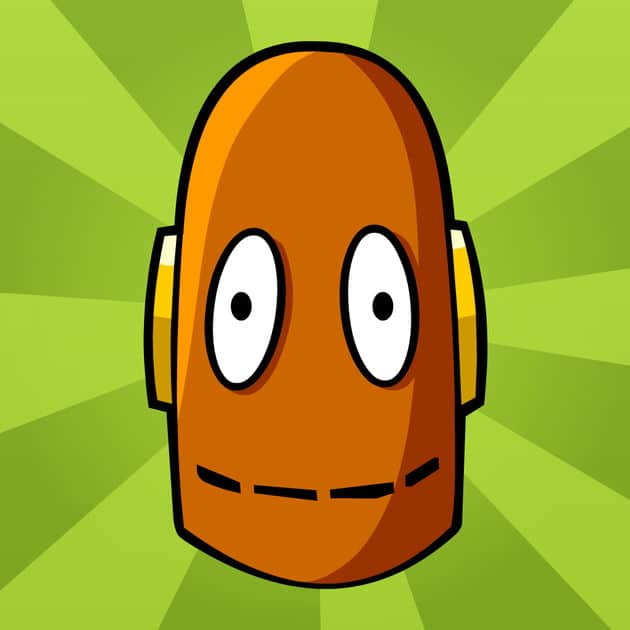
43 Fun Spanish Activities and Classroom Games
Is there any sight better than a classroom full of smiling students?
Incorporating things your students love to do into language lessons will lead to effortless learning that may actually be—gasp—fun!
Chances are, the vast majority of them, no matter their ages, love games.
Whether their favorites are video games, board games, schoolyard games or some other sort, all students are jazzed to get in some playtime during class time.
In this post, I’ll share 43 engaging Spanish activities and games for grammar, vocabulary and speaking practice.
Contents
- Fun Spanish Vocabulary Games
- Spanish Activities for Practicing Grammar
- Spanish Activities For Speaking Practice
- Traditional Fun Spanish Games
- Interactive Group Spanish Activities
- 31. Globo (Balloon)
- 32. Duelling Fingers
- 33. Cuenta atrás (Countdown)
- 34. En el ático de mi abuela (In My Grandmother’s Attic)
- 35. Voy a Sevilla (I’m Going to Seville)
- 36. Frío, tibio, caliente (Cold, Warm, Hot)
- 37. Zapatito cochinito (Dirty Little Shoe)
- 38. Piedra, papel o tijera o lo que sea (Rock, Paper, Scissors or Whatever)
- 39. Canasta de frutas (Fruit Basket)
- 40. El baile de la silla (Musical Chairs)
- 41. Carrera de Relevos (Relay Race)
- 42. Two Truths and a Lie
- 43. Who Am I?
- Spanish Apps and Computer Games
Download: This blog post is available as a convenient and portable PDF that you can take anywhere. Click here to get a copy. (Download)
Fun Spanish Vocabulary Games
There’s a lot to cover here, but first, we’ll explore games to amp up your students’ Spanish vocabulary.
1. El Juego de Correr (The Running Game)
Focus: Vocabulary
To play this game, split your class evenly into two teams. Start counting at #1 and give a different sequential number to each member of the team. Then dole out these numbers to the other team’s players as well. If there are 12 students in your class, this means that you’ll now have two groups of 6 with students numbered from 1-6.
Have each team line up in a row. Next, say any English word and then a number in Spanish. For example, “apple” and “nueve” (nine).
Both students numbered “nueve” should rush to the whiteboard and write “manzana” (apple) as quickly as possible. The winner is then awarded a point. The game continues until one team scores the winning number of points (determined by you or your students).
2. Bingo
Focus: Vocabulary
Bingo is a tried and true game that makes practicing new vocabulary engaging and interactive for students.
To play, print out blank or prepared Bingo grids for each of your students. You can fill out the grids with an assortment of vocabulary that you’ve been teaching lately. If the cards are blank, have the students fill in each blank on their grid with a different vocabulary word.
Afterwards, call out each of the vocabulary words. The first student to get an entire row (vertical, horizontal or diagonal) yells out “Bingo!” and wins. Once many students have a “bingo,” you can continue to play for “blackout,” meaning the entire board is crossed out.
For a free bingo card generator, check out print-bingo.com or osric.com.
3. Listas (Lists)
Focus: Vocabulary
Divide students into groups of three or four. Give them all the same topic, for example, school things, fruits, sports or colors. Have each group write down as many Spanish words that relate to the topic as they can think of. Give them between ten and fifteen minutes to do this.
Have teams state the total number of words on their lists. Then have one team read their list and have the other teams cross out words that the first team has listed. The next team to read their words aloud will have a shorter list, as they read only words not listed by the first team.
Continue until all teams have read their lists. Write the words unique to each list on the board.
5. ¿Qué es? (What is It?)
Focus: Vocabulary
This game will get those neurons firing in your students’ minds as they try to guess certain Spanish objects.
For this activity, you’ll need a deck of cards with pictures of different things on them. You can do any category you like: foods, animals, colors, etc. You can then pick students one by one or ask for a volunteer to come up to the front and select a card.
Instruct the student to show the card to the rest of the class without looking at it themself. Then, the student will have to guess what’s on the card they selected based on clues from the rest of the class.
This should all be done 100% in Spanish, of course!
6. Hangman
Focus: Vocabulary
This is a ridiculously well-known classroom game, so I shouldn’t need to explain too much how it works.
Its purpose in a Spanish class is to reinforce letters of the alphabet and improve vocabulary. Simply write out a blank space for each letter of a word in Spanish, then let your students guess the letters—either “every man for himself” style or in teams.
A couple of neat variations of the game include Parachute Man and In and Out, the latter of which has slightly different playing rules.
7. Circumlocution Game
Focus: Vocabulary
Ever have a word on the tip of your tongue, but you just can’t remember it? Or, do you ever want to describe something but you don’t know the word for it in another language? Well, this game is useful for these moments!
At the start of class, divide your students into pairs or groups of up to four. Next, write a broad or specific topic on the board. For example, comida (food) or, more specifically, frutas rojas (red fruits).
Once all students have read the category, have all of the students in the group except one turn away from the board. Next, write some vocabulary words specific to the category on the board.
For the frutas rojas example, you could write manzana (apple), fresa (strawberry), tomate (tomato) and frambuesa (raspberry). The one student per group who can see the board must then describe the vocabulary words without actually saying them. This will force them to venture out of their vocabulary comfort zones and get creative with adjectives!
8. Párame el carro (Stop the Car)
Focus: Vocabulary
Also known párame la mano (stop the hand) or tutifruti, this is a rich learning game that’s super popular in Ecuadorian schools.
Have each student take out a blank piece of paper, draw lines to break it into columns, then label them as Nombre (name), Apellido (last name), Cosa (thing), Fruta (fruit), Color (color), Animal (animal), Ciudad (city) or País (country) and Total (total). No matter what you’re currently teaching, you can change up the categories to match!
Each round, provide a letter of the alphabet and have students fill out the categories with Spanish words that start with that letter.
The student who finishes first yells “¡párame el carro!” and everyone else stops writing. Each word has a score (you decide how many points). Sum up all the words and write down the total each round.
9. Word Snake
Focus: Vocabulary
Have your students stand in a line facing the whiteboard. There’s an initial word up on the board to get the game started, such as sol.
The first student must come up and write a word that begins with the last letter of the previous word, so they could go from sol to lluvia. The words should be joined together to make a snake: sol/lluvia/amigo/oro, etc.
You can add constraints to ramp up the difficulty depending on the level of your group. Imposing a three-second time limit, no words with fewer than five letters, or only adjectives are all rules that make the game more challenging.
10. Picture This

Focus: Vocabulary
Give your students a picture, face down. Students tend to be naturally quite curious about their teacher, so copies of personal photos work very well here.
When you start an egg-timer, the students are allowed to flip over the picture. They must try to memorize as much about the picture as they can.
After the timer is finished, take away the pictures and instruct the students to write down as many vocabulary words that describe the picture as they can remember. When they are finished, put the picture up on the board and discuss the different words and phrases that they jotted down.
Spanish Activities for Practicing Grammar
Grammar is an important part of any language. But how can you make learning verb conjugations and other grammar fun?
Here are some fun Spanish activities for practicing grammar with your students:
11. Sentence Matching
Focus: Grammar (verb tenses)
The first step in this activity is to type and print out sentences in Spanish. These sentences should all use the grammar points you’re currently teaching. For example, if you’re teaching pretérito versus imperfecto, you could use the sentences cuando era nino, él bailaba todos los días and el sábado pasado, yo fui al supermercado.
Once you print out several sets of sentences, cut each sentence in half. When teaching verb tenses, have the subject on one half and the conjugated verb on the other.
In class, break the students into groups. Give one set of sentences to each group. Next, have the students match the scrambled sentence halves up. Once the students think they have a match, ask them to write it down on a blank sheet of paper.
To motivate your students further, you can turn the game into a little competition by having the groups race to see who can finish first.
12. Verb Tic-Tac-Toe

Focus: Grammar (verbs)
Tic-tac-toe, three in a row! Unlike the version of this game with which your students are already familiar, they’ll have to do a bit more work to win the Spanish verb version.
First, have your students pair up. Next, ask each one to draw a tic-tac-toe board with various subjects in the spaces. For example, they could write nosotros (we) in one square and yo (I) in another.
To play, students will need some kind of reference sheet filled with Spanish verbs. You could whip one up yourself to print and distribute in class, or you could have them use the index of a verb conjugation book or choose from a deck of cards with verbs written on them.
To start taking their turns, have the students choose verbs by pointing to a random one on the reference sheet, book index or deck of cards.
Each round of the game should focus on a particular verb conjugation. For example, “for this round, we’ll conjugate in the imperfecto.” When the student is up at bat and wants to put an X or O in a certain box, they’ll need to consider the verb tense you indicated, the subject in the square and the random verb that they and their partner selected.
They’ll then need to do the conjugation for the selected verb properly. If they don’t get the conjugation right, they don’t get their square.
Whoever gets three Xs or Os in a row first wins!
13. Simón Dice (Simon Says)
Focus: Grammar (commands) and vocabulary
Simón Dice, the Spanish version of the classic game, is a perfect way for your students to practice mandatos (commands) and vocabulary simultaneously.
Ask for one student to volunteer or pick on someone to come to the front and be Simón. Simón either commands the students to perform an action—for example, Simón dice: siéntense (Simon says: sit down)—or Simón conjugates a verb alone. Anyone who does an action that isn’t preceded by “Simón dice” is out!
Depending on your class size, give every student the opportunity to be Simón two or three times. Keep an eye out for any Simón who avoids making commands as that phenomenon may reveal that they don’t quite understand the grammar concept.
14. Direcciones (Directions)
Focus: Grammar (giving directions)
Just in case Simón Dice didn’t provide enough mandatos fun for your students, there’s always the game Direcciones.
During this activity, ask your students to partner up. Distribute maps of cities and ask your students to take turns leading each other to destinations on the maps.
The student giving the directions should have a destination in mind, but they can’t share it with their partner. The partner being guided must listen carefully and make their way to the intended destination on the map.
Mes-english.com has a simple option of a town map that works for this exercise.
15. Cucharas (Spoons)
Focus: Grammar (verbs) and vocabulary
Perhaps you’ve heard of (or have played) the card game “spoons.” This is simply the Spanish twist on the game, which can be used to teach or review Spanish verbs or vocabulary.
First, make a deck of about 50 cards for each group of about six students that’ll play in class. What goes on these cards? Well, that’s totally up to you and your current teaching topics. Generally speaking, you’ll want to have 25 cards with 25 matching cards.
The first half might be infinitive verbs, and the second half might be conjugated versions of these verbs. Or the first half could be conjugated verbs and the second half could be subjects that match up with them. Once you’ve gotten your content created, print out the flashcards.
When the students can match two related cards, they can take a spoon from the center of the table (and try to do so without the other group members noticing). When other players notice that a spoon is being taken, they too may grab a spoon.
Whoever gets the most spoons at the end wins!
16. Always, Often, Never
Focus: Grammar (adverbs)
In this game, students must write three complete sentences in the first person on a sheet of paper. One sentence must contain the word siempre (always), one must contain a menudo (often) and one must contain nunca (never).
To make the game more challenging, add more sentence requirements with more subtle adverbs, like raramente (rarely), a veces (occasionally) and en otro tiempo (once or formerly).
Collect the sentences, read them out loud and ask class members to identify the writer of the sentences. This game doesn’t require a lot of time or resources, so if your students enjoy it, offer it as a reward for good behavior.
Focus on intermediate sentence writing skills and the use of adverbs for informal conversational practice with this game.
17. Twenty Questions

Focus: Grammar (gender rules)
Give the classic game “twenty questions” a little twist by putting a Spanish spin on it.
In pairs or groups, ask students to ask each other twenty yes-or-no questions until they can guess what the other students have in mind. For example, they can ask questions like: “¿Es una fruta?” or “¿Es un animal?” This is perfect for teaching and reinforcing Spanish gender rules.
Your students can build on each question as they attain more information about what their classmates are thinking. So if a student answers “sí” to “¿es un animal?” the questioning student can then ask “¿es un animal pequeño?”
18. Get Rid of It!
Focus: Grammar
You can use this game to revise fairly tricky grammar topics.
Put a collection of question cards into a hat. Give your students a number of word or phrase cards each. Pull out a question at random and read it aloud to the class. Your students must look at their word or phrase cards and see if they are holding the answer.
For example, the teacher might read the question “¿Qué hora es?” One student might have a card with “Son las tres.”
If so, they can read out the answer and get rid of their card. The first to get rid of all their cards wins.
19. Charades

Focus: Grammar (gerund)
Charades, the amusing and occasionally embarrassing acting game many of us played as kids, is yet another activity just itching to get a Spanish makeover.
To prepare for the activity, print out a list of actions, cut them up and place them in a bag. When a student volunteers to demonstrate an action, have him or her draw a sentence from the bag. Have the students take turns guessing what the student is acting out. This is ideal for practicing gerunds.
To keep things interesting for your students, make the game into a competition. For example, students who guess the action correctly can get two points and the ones who volunteer can get one.
20. Superlative Olympics
Focus: Grammar (superlatives)
Who’s the fastest in your class? Who has the longest hair? Who’s the tallest?
Time to find out by playing Spanish Superlative Olympics!
Split your class into two or three large teams. Ask them to choose contenders for different categories to participate in class Olympics. For example, el estudiante con el pelo más largo or el estudiante que puede saltar lo más alto.
Have the nominees for each category stand up in front of the class and demonstrate their skill. Have the best dancer nominees do a little solo and have the longest hair contenders hold up a ruler by their locks. Then have the class select a winner by applauding for their classmate of choice.
In the end, you can hand out some prizes to the winners of the game!
21. Grammar Jeopardy
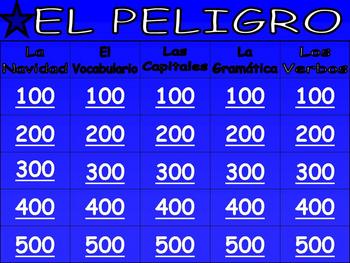
Focus: Grammar (noun gender)
One of the best aspects of Spanish Jeopardy is that you can use it as a tool for basically any lesson you’re currently teaching.
Create a Jeopardy game board with categories related to different parts of Spanish grammar. Split your class into teams and have them choose categories and points. One category could be “¿masculino o feminino?”
If a student chooses this category, they’ll have to determine if a word is masculine or feminine. For higher points, the words should get more and more difficult, like the word “problema.”
Depending on how much time you have, you could have the winners proceed to another round.
22. Comparison Card Game
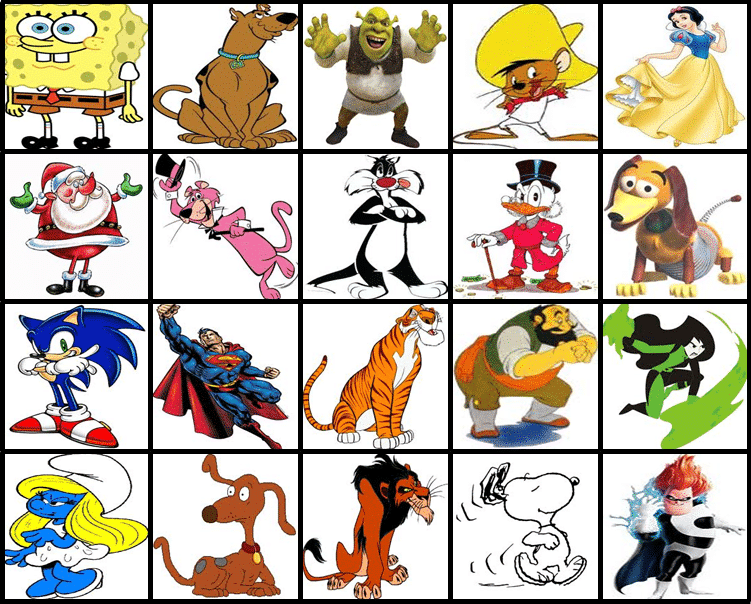
Focus: Grammar (adjectives)
Make many playing cards with pictures of famous cartoon characters and statistics about the characters. For example, you can make a playing card featuring Belle from “Beauty and the Beast” which shows her age, height, interests, etc.
In addition to the cards, print out a number of adjectives in large font and cut them into individual cards.
Split your students into groups. Ask your students to draw two cards from the stack of characters and one card from the stack of adjective cards.
Next, have them write sentences comparing the different characters. For example, if a student picks Belle, Mario and the adjective alto, the student could then write “Belle es más alta que Mario.“
At the end of the activity, ask each group to choose their favorite sentence and share it with the rest of the class.
Spanish Activities For Speaking Practice
When learning a language, it’s important to practice speaking it as much as possible.
Speaking activities will help your students gain confidence not only using the language but also thinking in the language.
23. Restaurante (Restaurant)

Focus: Spanish speaking practice (food and meals)
Pair students up and have them decide who will be the mesero (waiter) and who will be the cliente (customer). Meseros bring clientes their menus and jot down their orders on the guest check, then go to “cook” the meal requested.
This is done by drawing the meal on the plate worksheet. When they serve the cliente, they’ll know right away if they got the order right, and clientes can leave additional feedback by tipping well (or not at all!). Students should switch roles for the second round.
Another great way to play this game with your students is by asking them to make their own menus to practice writing and tailor the game to your specific vocabulary. Menus can also include culturally specific foods if you’re studying a particular country or region.
You can also allow clientes to sit together and chat in Spanish while they wait for their meals.
24. ¿Adivina Quién? (Guess Who?)

Focus: Spanish speaking practice (physical appearances, clothing)
To play this game, hang photos in a grid on the board where everyone can see them, or project a PowerPoint slide containing 20-30 photos of people. Working in pairs, one student will choose a photo of a person to describe. The other student asks questions about appearance and clothing to narrow the field until he or she is ready to guess. Partners switch roles and play continues.
For an even easier version of this game, skip the photos and have students simply choose a classmate to describe.
Use portraits to focus on facial features or full-length photos to practice clothing and color vocabulary.
25. Mi Familia Loca (My Crazy Family)
Focus: Spanish speaking practice (family and pets)
In pairs, students sit facing each other with a binder standing between them to block the view of each other’s family tree template. One student will place photos on the family tree template to create a familia loca.
The second student must recreate that family tree without looking, so will ask questions like, “¿Quién es tu mamá?” (Who is your mother?), using the answers to place photos on their family tree. When the tree is complete, students remove the binder and check their work.
To make the game more challenging, use photos of non-famous people to force students to also use their physical description vocabulary, i.e. Mi mamá es alta y rubia. (My mother is tall and blonde.) If you use photos of animals instead of people, you can incorporate a review of Spanish animal sounds as well.
26. El Taxista (Taxi Driver)

Focus: Spanish speaking practice (professions and workplaces)
Divide the class in half: Half of your students are taxi drivers, and the other half are customers. Each taxi driver chooses a station and sits in the “driver’s seat.”
Customers each get a handful of play money and must decide what person they need to see (a pharmacist, teacher, lawyer, etc.). Each customer sits in the “passenger’s seat” of a cab station and gives a clue about where they are going—without naming the person they need to see or the place they are going.
For example, someone going to the doctor might describe having a headache. The taxi driver makes a guess about the location based on the clue. If the taxi driver is correct on their first guess, the customer gives him or her $5; if not, the passenger gives another clue. A correct guess on the second guess is worth $3.
If a third guess is needed, the customer can name the profession of the person they wish to see; a correct guess is now worth $1. When the round is over, customers move into a different taxi station and play continues. The taxi driver with the most money at the end wins.
You can make this game more or less challenging by structuring the questions and answers to match students’ skill level.
27. Limpia Tu Cuarto (Clean Your Room)
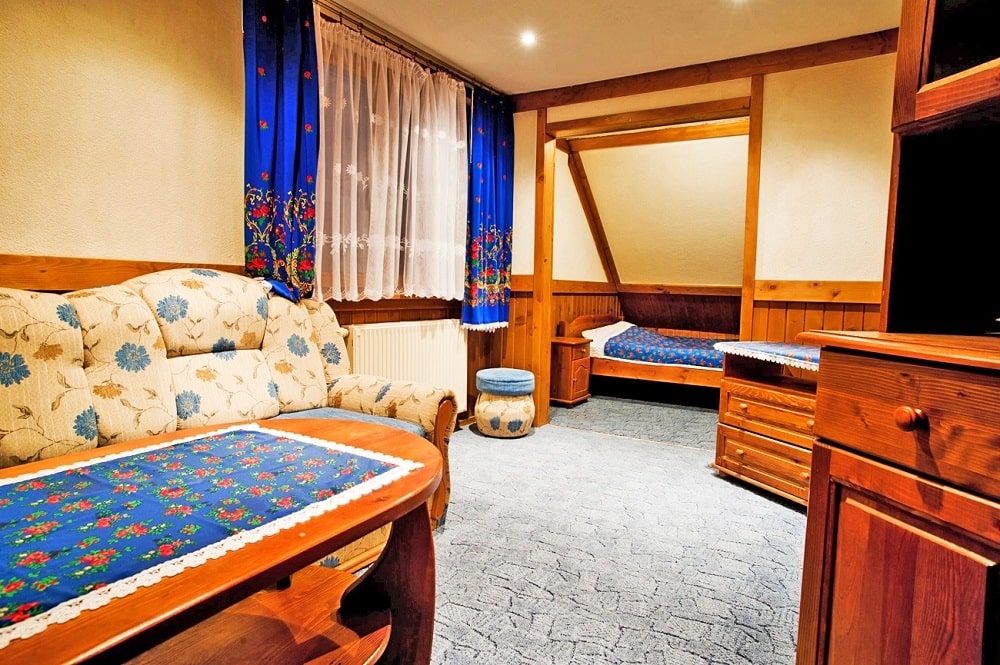
Focus: Spanish speaking practice (parts of the house and its furnishings)
Students play in pairs, with a binder or folder standing between them to keep their home diagrams secret from the other player. Each student selects a photo card to place in each room—locations do not have to make sense. The goal is to “clean up” your partner’s items before he or she can clean up yours.
To play, one student must ask the other for an item, i.e. “Necesito una silla. ¿Está en la cocina?” (I need a chair. Is it in the kitchen?). If they correctly guess the location of the item in their partner’s house, the partner must hand them the photo. Play continues as students take turns guessing; the first person to collect five items wins.
You can also play this game with photos of family members, pets, food and clothing instead of furniture to keep the game interesting over the course of the school year.
28. Rubber Cube
Focus: Spanish speaking practice (question words)
This game uses a rubber cube with question words written on each side, such as ¿Cómo?, ¿Cuándo?, ¿Dónde?, ¿Por qué?, ¿Quién? and ¿Cuál?. A student will throw the cube onto the table, like rolling a dice.
If, for example, the word ¿Dónde? appears face up, then the student who threw the cube must ask a question using the word ¿Dónde?. He or she might ask the person next to him, “¿Dónde vive tu madre?”.
Then the student who answered the question asks the same question to someone else in the classroom, until everyone has had a turn to ask and answer. Then the cube is thrown again.
Traditional Fun Spanish Games
Sometimes classic and traditional games are perfect for practicing Spanish vocabulary and getting in some speaking practice. Often students will already know how to play these popular games and so you won’t have to spend as long organizing your class or giving instructions.
29. Lotería (Lottery)
Focus: Speaking practice and vocabulary
You can buy an inexpensive, authentic lotería (lottery) game on a trip to Latin America or in a teaching materials store, or you can simply print out your own cards from the Internet.
Here are some resources for setting up a winning game of lotería:
- (Printable Lotería Cards) Free Kids Crafts
- (Adorable Mini Lotería Cards) Bees Knees Industries
- (Free DIY Cards and Lotería Announcer) Maravilla Software
This game is like Bingo but with pictures instead of numbers.
You can be the announcer (the person who calls out the card content) or have students take turns with this role. When a card is called, the whole class should repeat the word(s) together and then hunt for that picture on their table (card, literally “board”).
You can use dried beans to mark the pictures that are called so you can reuse the tablas. When a student fills up the card, they shout “lotería!” and win. Have the winner read the words from their tabla aloud so you can ensure they really did win.
30. Pictionary
Focus: Vocabulary
Depending on the size of your class, either divide the class into two teams to play against each other or invite students to take turns drawing for the class as a whole.
You’ll give the artist a word or phrase in Spanish, and the artist must represent the word silently in a drawing on the board without using any letters or numbers. If playing in teams, the team members must guess the word for a point, or if playing as a whole class, the audience members must guess the word for individual points.
Keeping score is optional, so you decide if there’s a good reason to record the points.
This game is fun and easy to implement, so even brief speed rounds can be useful if energy is low in your classroom or if students seem like they’re lacking enthusiasm.
Interactive Group Spanish Activities
A great way to get your students interacting with each other in Spanish is by using fun group activities which encourage them to move around the classroom.
31. Globo (Balloon)
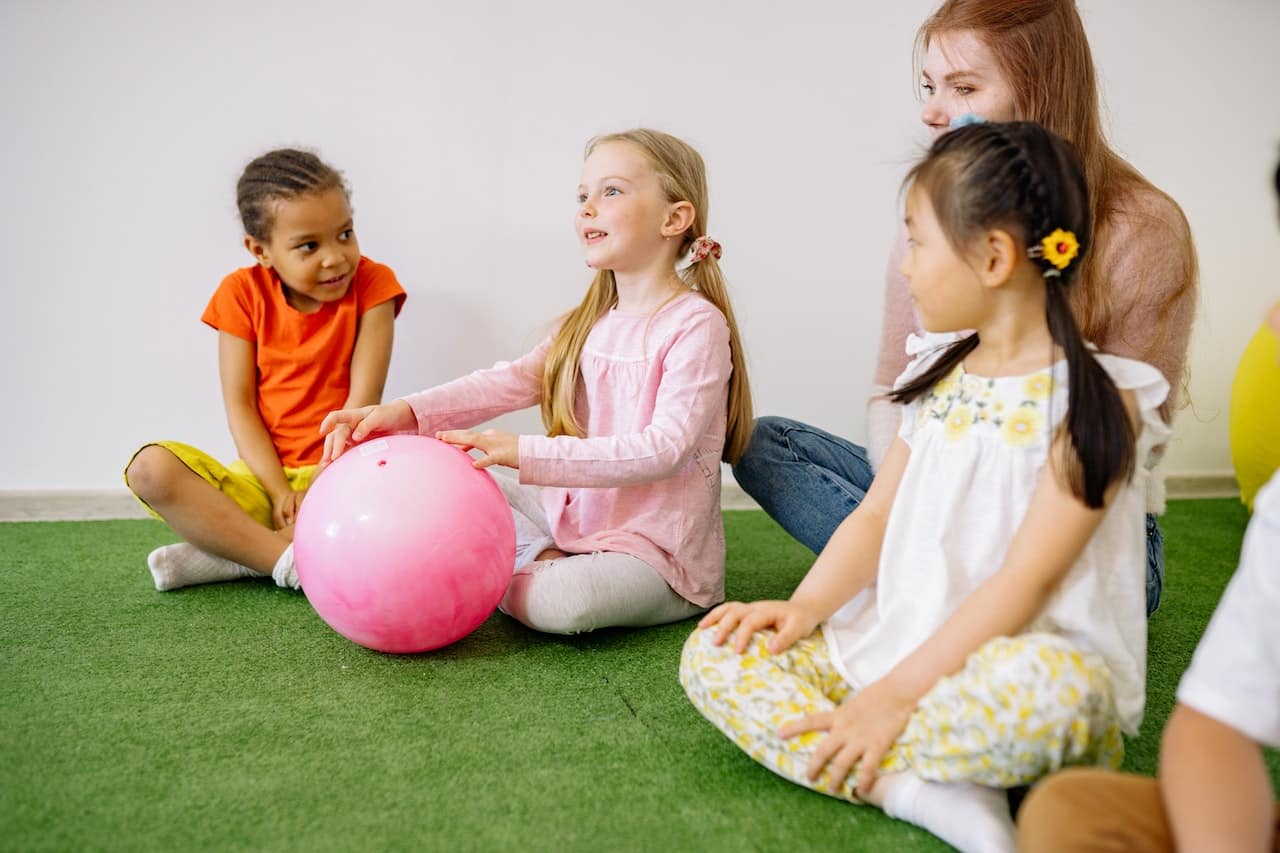
Focus: Grammar, vocabulary, speaking practice
Prior to this game, you’ll need to track down a soft sports ball. It’s probably best to play Globo outside or in a gymnasium, if possible.
Have students take turns throwing the ball. If the ball hits a certain object (for example, the wall or a tree), then the student gets a question corresponding to a specific category. You could say that hitting the tree means the student gets a grammar question.
Need ideas for questions to ask? Check out e-spanyol.com or take exercises from the textbook or workbook you use in class.
This is a nice, easygoing game that really doesn’t have winners or losers, it just gets everyone moving, active and thinking on their toes.
32. Duelling Fingers
Focus: Vocabulary, listening practice
Get your students to stand in a circle and have the teacher stand in the middle. The teacher picks somebody’s name and says it aloud. That student must duck and the students on either side must “shoot” one another with their magic fingers and say the key vocabulary word as quickly as possible.
If the person whose name was called is slow to duck, they are out of the game. If the person ducks quickly, the learner with the slowest fingers, as judged by the teacher, is out.
Once your class already knows each other’s names, you can tweak the game by describing particular people in Spanish. If learners are being described, they should duck quickly! For example, if the teacher says, “La muchacha con una camiseta amarilla,” then the girl wearing a yellow t-shirt should duck down.
As soon as your learners understand the rules, encourage one of them to step into the middle of the circle.
33. Cuenta atrás (Countdown)
Focus: Grammar, vocabulary, speaking practice
Have students stand in a circle. If you have more than a dozen students, make two groups.
Announce the highest number that will start the countdown and throw a ball to one of the students. He should say the next number down and throw the ball to another student. For example, you say “cien” (100) and throw the ball. The next student says “noventa y nueve!” (99) and throws the ball.
A soft, sponge ball works well for this game. If you want to slow down the game for beginners, use a balloon. The throws are random, so students must pay attention—the next turn could be theirs!
34. En el ático de mi abuela (In My Grandmother’s Attic)

Focus: Memorization (vocabulary, grammar, sentence structure, etc)
This is a repetition game. Each player repeats what was said by the previous player and adds something.
Make it more productive by having everyone repeat the entire sentence together before the next player adds an object. Things can be funny, outlandish or even impossible. This is good practice for matching articles with nouns and using “hay” (there is).
En el ático de mi abuela hay una licuadora. (In my grandmother’s attic there is a blender.)
En el ático de mi abuela hay una licuadora y un fútbol. (In my grandmother’s attic there is a blender and a football.)
If players want they can make notes but remember that exercising your memory makes it stronger, just like exercising your muscles.
35. Voy a Sevilla (I’m Going to Seville)
Focus: Vocabulary
Another repetition game with a twist. You will need to break students into groups if your class is large. Each group (or the whole class) will have a student appointed as the game leader. The leader chooses a category of items and names one. Here are some examples of categories:
- Things that grow in the ground
- Words that begin with the letter L
- Animals
- Vegetables
- Clothing
- Things in the water
So the leader says that they’re going to Seville and names one item from the chosen category that they’re taking with them. For example, if the student leader thought of textiles (textiles) as a category, they might then say “voy a Sevilla y llevo un kilo de algodón.” (I’m going to Seville and taking a kilo of cotton.)
The goal for the other players is to get the leader’s permission to accompany them to Seville. They can only go if they have an item in the leader’s category of items. One player might say, “tengo un pez, ¿puedo ir también?” (I have a fish, can I go too?). The leader answers “no” in this case.
If a player names an item in the same category, then the leader says “¡sí!” and that student wins the round.
36. Frío, tibio, caliente (Cold, Warm, Hot)
Focus: Vocabulary
Ask a student to leave the classroom for a second, and deliberate among the other students in Spanish: What should you guys hide and where? Ideally, you’ll hide an object relevant to the topic you’re teaching in your class at the time.
Make them find it while y’all sing and chant “¡Frío, frío, tibio, caliente, caliente!” As they search, the class yells “¡Frío, frío, tibio caliente, caliente!” (cold, cold, warm, hot, hot!). The closer they get to the object, the louder you shout “¡caliente!”
This sample video is in an English classroom, but it shows what a blast this can be for students:
37. Zapatito cochinito (Dirty Little Shoe)
Focus: Speaking practice
My husband grew up playing this game as a kid in Ecuador. In essence, it’s their version of “eeny meeny, miny, moe,” a selection or choosing game.
To play this, students gather together in a circle, make an inner circle with their right feet, then sing this Spanish song one word at a time: “Zapatito Cochinito, cambia de piecito porque mi mamita dijo que lo cambies tú.” (Dirty Little Shoe, change your little foot because my mommy said that you must change it.)
Each player says two syllables and taps their foot on the floor as they say them. When the song ends, the person who said the final syllable must change their right foot for the left one. If they’re at the end a second time, they’re outta there! The last student standing is the chosen one.
For teachers only, here’s a funny video from a humorous Ecuadorian variety show:
38. Piedra, papel o tijera o lo que sea (Rock, Paper, Scissors or Whatever)
Focus: Speaking practice
You know how it typically goes: Rock, paper and scissors are the options. In the Spanish version, you can add a thumbs-up gesture to represent dynamite and blow the whole game out of the water. But each player can only use it once in each three-round game.
The simple Spanish rhyme goes:
Piedra, papel, tijera o lo que sea (Rock, paper, scissors or whatever)
Uno, dos, tres (one, two, three)
Here’s a demonstration in Spanish, with a slightly longer rhyme:
If you like her longer rhyme, then you can use it in class—and you can even follow her rhyme to change “menos una papelera” (except a waste bin) with another creative rhyme!
39. Canasta de frutas (Fruit Basket)
Focus: Vocabulary
Set up a circle of chairs that’s one less than the number of students.
Have everyone stand in front of the chairs in a big circle. Then, everyone needs to become a fruit.
Start the game by calling out “¡ensalada de frutas!” (fruit salad). Everyone has to run as fast as they can to nab a new seat.
Whoever didn’t get a chair becomes “it” and goes to the center of the classroom. They start the first real round by calling out a random fruit, for example, “naranja” (orange). Now only the naranjas run as fast as they can to change seats, as does the kid who’s “it.”
The student who didn’t make it and has no seat will be the new “it,” and ends up calling a new fruit. If somebody yells “ensalada de frutas,” everyone has to book it!
Not a Spanish version, but this video shows how the gameplay works:
The best part is that you can vary this up for any theme of vocabulary: professions, countries, languages, animals, foods, family members.
40. El baile de la silla (Musical Chairs)
Focus: Listening practice
Bring your classroom chairs together into a tight circle with their backs all together. As before, you’ll want one chair fewer than there are students.
First things first, pick lively songs. Two Spanish classroom favorites are “La Bamba” by Ritchie Valens and “Guantanamera” by the incomparable Celia Cruz. For middle schoolers, you may want to opt for current Spanish pop songs or a little Shakira.
Play the song for the game. When you stop the music, all the students need to scramble for a seat.
Whoever’s out is out for good. Remove one more chair, and play again with the remaining group. Rinse and repeat until you have a winner!
41. Carrera de Relevos (Relay Race)
Focus: Vocabulary
Younger students love this game that gets them moving and using their hands.
Collect several unbreakable items that relate to your lesson, or at least represent words they have learned. Examples might be plastic fruits and vegetables, toy cars, plastic tableware—spoon, fork, plate.
Divide them into two teams and line the teams up at the far end of the teaching space. Put the items in a large box at the other end of the space.
The leader stands between the two teams and calls out an item in Spanish. The first person on each team must run to the box, find the correct item and bring it back to the leader.
The leader keeps score, giving one point to the team that brings back the correct item each time. Announce the score from time to time.
This game gets interesting when the equipos están empatados (the teams are tied). Continue playing until every student has had a chance to bring back an item. All the kids will be laughing and ready to sit still after this game.
42. Two Truths and a Lie
Focus: Vocabulary, sentence building and conversation practice
Everyone writes down three complete sentences about themselves in Spanish. Two must be true and one must be a lie. Suggest that the lie be something that could easily be true, so that it’s harder for the others to identify the lie.
When it’s one student’s turn to read their sentences, everyone else’s job is to identify the lie.
The game can also be adapted so that the sentences must contain specific material, such as vocabulary words from a particular list, or grammar concepts that are useful to sentence-building like practice with ser (to be) and estar (to be).
43. Who Am I?
Focus: Writing, reading and question-forming practice
Give the students index cards and ask them to write down three complete sentences about themselves describing activities they enjoy, musicians they like, places they’ve been and other fun details.
Then ask students to fold the index cards in half and turn them back in to you.
Distribute the folded cards so that each student gets a new one. They must read the sentences and then develop a series of questions to ask the other students to discover the original owner of the index card.
For example, if the sentence on the card reads “Viajé con mi familia a las islas Canarias” (I traveled with my family to the Canary Islands) a corresponding interview question might be, “¿Te gusta viajar en avión?” (Do you like to travel by airplane?)
Next, allow students to mill around asking one another their interview questions.
Once everyone’s seated again, ask students to share the results of their interviews and introduce one another to the rest of the class.
This game pairs well with lessons on forming questions in Spanish. It’s also an icebreaker-style game that works well at the beginning of the school year.
Spanish Apps and Computer Games
What student doesn’t have a phone in their pocket these days? As technology continues to make its way into classrooms, you, too, can take advantage of the wide range of resources that are available to the tech-savvy teacher.
Here are a few options you could try using in your Spanish lessons:
Younger students will enjoy BrainPOP’s Spanish content, which has games, videos and quizzes in Spanish on a variety of topics like science, math, art and more.
Students are sure to be charmed by Moby the robot and his friends, and you can easily incorporate elements from the website into a game-based lesson.
FluentU
FluentU is a language learning tool that immerses students in authentic videos that native Spanish speakers watch, including movie trailers and commercials.
Since the videos have interactive subtitles, you can make it a game with students to pick out words in videos and compile a vocabulary list for the whole class. You can then assign the app’s flashcards or quizzes as homework.
Draw With Friends
An app doesn’t have to be specifically created for educators: a game like Draw With Friends (Android / iOS), for instance, is a tech take on Pictionary.
While answers must be typed, you can encourage students to speak out loud, which will get students speaking in Spanish spontaneously as they try to guess what their opponents are drawing.
Some of the best games have simple rules and get students talking. Remember, it doesn’t have to be complicated to get your students thinking and speaking in Spanish!
For even more resources on game or lesson ideas for the Spanish classroom, there are tons of sites that you can visit on the internet.
As long as you’re ready and able to have some fun, games will become an effortless addition to your lesson plans.
Download: This blog post is available as a convenient and portable PDF that you can take anywhere. Click here to get a copy. (Download)
